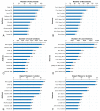Global status and trends in heart failure with preserved ejection fraction over the period 2009-2020: A bibliometric analysis
- PMID: 35356948
- PMCID: PMC10684182
- DOI: 10.1097/MD.0000000000029106
Global status and trends in heart failure with preserved ejection fraction over the period 2009-2020: A bibliometric analysis
Abstract
Background: Heart failure with preserved ejection fraction (HFpEF) comprises about 50% of the cases of heart failure (HF), but so far there is no effective treatment strategy. This study used bibliometric methods to analyze the scientific literature on HFpEF in 2009 to 2020, and evaluate the global scientific output of HFpEF research, in order to explore the research status and trends in this field.
Methods: Documents about the HFpEF research published in 2009 to 2020 were retrieved from Science Citation Index Expanded (SCIE) in Web of Science. This study used bibliometrix R-package, VOSviewer, and CiteSpace to conduct the bibliometric analysis.
Results: A total of 1971 documents (1508 articles and 283 reviews) were retrieved to construct the local HFpEF literature collection for analysis. The number of annual documents had increased year by year in general, from 24 to 353. Relevant documents were mainly written in English, and mostly focused on the field of "Cardiovascular System Cardiology." USA ranked first in the relevant countries/regions with most documents, and the leading affiliation was Mayo Clin. Shah SJ was the most productive author, while Borlaug BA ranked highest among the local cited authors and G-index. Circulation was the most local cited source, while Eur J Heart Fail published the most documents and was rated as the top source in terms of G-index. "Paulus WJ, 2013, J Am Coll Cardiol" was the top local cited document within the local HFpEF literature collection, while "Owan TE, 2006, New Engl J Med" outside the local HFpEF literature collection was the most local cited reference. The keywords such as "mortality," "dysfunction," "diagnosis," "outcomes," and "diastolic dysfunction" were most frequent, while "hemodynamics," "comorbidity," "myocardial infarction," "inflammation," and "phenotype" indicated research frontiers or emerging trends. Furthermore, this study also found some deeper bibliometric relationships through bibliographic networks.
Conclusions: Due to the multi-dimensional bibliometric analysis, this study shows a wide view of scientific productivity related to HFpEF, and provides valuable guidance for researchers interested in HFpEF, assisting them in understanding the research status, identifying potential collaborators, discovering research hotspots and frontiers, and conducting more in-depth research.
Copyright © 2022 the Author(s). Published by Wolters Kluwer Health, Inc.
Conflict of interest statement
Figures











Similar articles
-
A Bibliometric Analysis of Heart Failure with Preserved Ejection Fraction From 2000 to 2021.Curr Probl Cardiol. 2022 Sep;47(9):101243. doi: 10.1016/j.cpcardiol.2022.101243. Epub 2022 May 8. Curr Probl Cardiol. 2022. PMID: 35545178 Review.
-
Global trends in research on oxidative stress related to heart failure from 2012 to 2021: a bibliometric analysis and suggestion to researchers.Ann Transl Med. 2023 Jan 31;11(2):54. doi: 10.21037/atm-22-6573. Ann Transl Med. 2023. PMID: 36819531 Free PMC article.
-
Research Trends in the Application of Artificial Intelligence in Oncology: A Bibliometric and Network Visualization Study.Front Biosci (Landmark Ed). 2022 Aug 31;27(9):254. doi: 10.31083/j.fbl2709254. Front Biosci (Landmark Ed). 2022. PMID: 36224012
-
Knowledge Structure and Emerging Trends of Telerehabilitation in Recent 20 Years: A Bibliometric Analysis via CiteSpace.Front Public Health. 2022 Jun 20;10:904855. doi: 10.3389/fpubh.2022.904855. eCollection 2022. Front Public Health. 2022. PMID: 35795695 Free PMC article.
-
Research trends in the field of the gut-brain interaction: Functional dyspepsia in the spotlight - An integrated bibliometric and science mapping approach.Front Neurosci. 2023 Mar 8;17:1109510. doi: 10.3389/fnins.2023.1109510. eCollection 2023. Front Neurosci. 2023. PMID: 36968499 Free PMC article. Review.
Cited by
-
Bibliometric analysis of research trends in relationship between sarcopenia and surgery.Front Surg. 2023 Jan 6;9:1056732. doi: 10.3389/fsurg.2022.1056732. eCollection 2022. Front Surg. 2023. PMID: 36684140 Free PMC article.
References
-
- McHugh K, DeVore AD, Wu J, et al. Heart failure with preserved ejection fraction and diabetes: JACC State-of-the-Art review. J Am Coll Cardiol 2019;73:602- 11. - PubMed
-
- Youn JC, Ahn Y, Jung HO. Pathophysiology of heart failure with preserved ejection fraction. Heart Fail Clin 2021;17:327- 35. - PubMed
-
- Hong GR, Vannan MA, Bossone E. Heart failure with preserved ejection fraction: current opinion and future perspectives. Heart Fail Clin 2021;17:xiii- v. - PubMed
-
- Xanthopoulos A, Triposkiadis F, Starling RC. Heart failure with preserved ejection fraction: classification based upon phenotype is essential for diagnosis and treatment. Trends Cardiovasc Med 2018;28:392- 400. - PubMed
MeSH terms
LinkOut - more resources
Full Text Sources
Medical
Research Materials
Miscellaneous

